Table of Contents
Cooking and Math
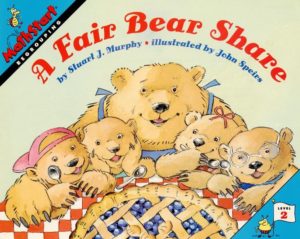
|
In Stuart J. Murphy’s A Fair Bear Share (HarperCollins, 1997), four little bear cubs gather, count, and sort blueberries, nuts, and seeds (in sets of ten) for their mother’s special Blue Ribbon Blueberry Pie. For ages 4-7. |
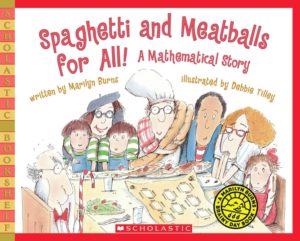
|
In Spaghetti and Meatballs for All (Scholastic, 1997) by Marilyn Burns, the Comforts have invited many guests for dinner – which turns into a clever mathematical exercise in rearranging tables and chairs and apportioning food. For ages 4-8. |
| From the BBC’s Good Food, Cooking with Kids: Spaghetti & Meatballs has a shared parent-and-kids recipe, with helpful instructions for each. | |
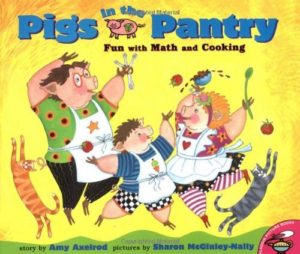
|
In Amy Axelrod’s Pigs in the Pantry (Aladdin, 1999) – subtitled “Fun with Math and Cooking” – Mrs. Pig has a cold so her husband and children decide to make her a batch of spicy Firehouse Chili (recipe included). Measuring errors lead to disaster. For ages 5-8. |
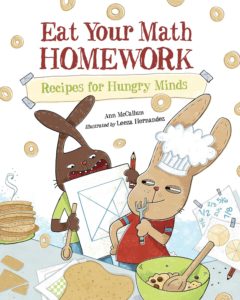
|
Ann McCallum’s Eat Your Math Homework (Charlesbridge Publishing, 2011) pairs food and math concepts (with a couple of wacky bunnies). Kids learn about probability with trail mix and pi with pizza, bake batches of tessellating two-color brownies and tangram cookies, and make Fibonacci snack sticks. Informative and fun for ages 7-12. |
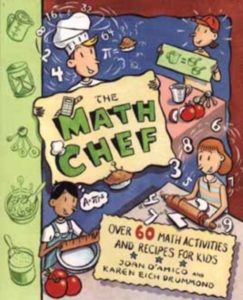
|
The Math Chef: Over 60 Math Activities and Recipes for Kids by Joan D’Amico and Karen Eich Drummond (John Wiley & Sons, 1997) is divided into four main sections: “Measuring,” “Arithmetic,” “Fractions and Percents,” and “Geometry.” Kids combine mathematical exercises with cooking, calculating the number of grams in a pound of potatoes, figuring out how to triple a sandwich recipe, and determining the area of a brownie and the circumference of an apple pie. For ages 8-12. |
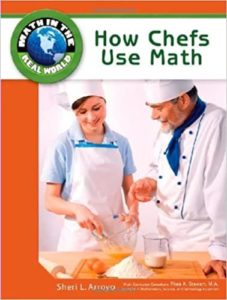
|
In the Math in the Real World series, Sheri Arroyo’s 32-page How Chefs Use Math (Chelsea Clubhouse, 2009) is an illustrated introduction to the mathematics of running a restaurant. How much food to buy? What to charge? How many customers? For ages 8-12. |
Cooking and Poetry
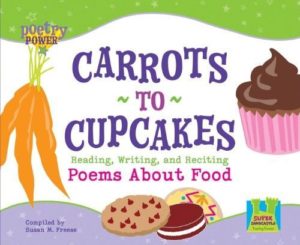
|
Susan M. Freese’s Carrots to Cupcakes (Super Sandcastle, 2008) introduces kids to basic poetry concepts through funny cartoon-illustrated poems about cooking and food. For ages 5-8. |
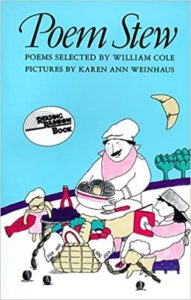
|
Edited by William Cole, Poem Stew (Harper Trophy, 1983) is a rollicking illustrated collection of poems about food by a wide range of poets. Try John Updike’s “Lament for My Cocoa.” (It’s gone cold.) For ages 6-12. |
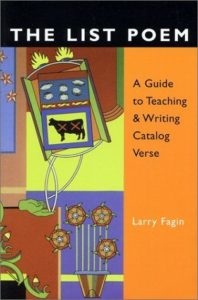
|
Larry Fagin, in The List Poem (Teachers & Writers Collaborative, 2000), a book of poetry exercises and projects for aspiring writers, suggests that students try writing “recipe poems” based on recipe-style lists of ingredients. Samples (by students) include “Recipe for Martin Luther King, Jr.” (“7 gallons of love/10 cups of courage/10 cups of caring…”) and a recipe for “King Midas Touch” (“1 pound egg shells/2 pounds of mosquitoes (bones removed)/1 purple duck with polka dots…”). For all ages. |
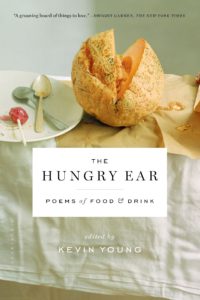
|
Kevin Young’s The Hungry Ear (Bloomsbury USA, 2012) is a collection of poems on food by many different poets, among them Mary Oliver, Seamus Heaney, Elizabeth Bishop, Langston Hughes, Billy Collins, W.B. Yeats, Pablo Neruda, and Sylvia Plath. For teenagers and adults. |
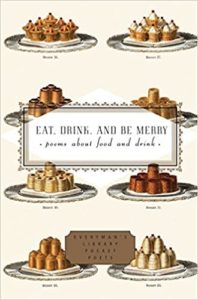
|
Peter Washington’s Eat, Drink, and Be Merry (Everyman’s Library, 2003) is an anthology of poems on food and drink, among them “Breakfast” by William Carlos Williams, “Blueberries” by Robert Frost, “Recipe for a Salad” by Sydney Smith, and “Gooseberry Fool” by Amy Clampitt. For teenagers and adults. |
Cooking and Art
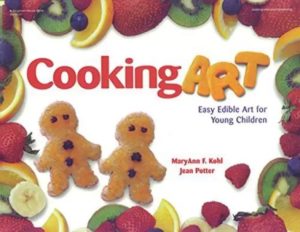
|
By Maryann F. Kohl and Jean Potter, Cooking Art: Easy Edible Art for Young Children (Gryphon House, 1997) is a fat collection of artistic cooking projects for kids aged 4-10. Projects are grouped under such subheadings as “Shapes and Forms,” “Colors and Design,” “Flowers and Trees,” and “Animals and Creatures.” There’s also a month-by-month list of special seasonal projects for around the year. Sample projects: kids make potato ghosts, number pretzels, cucumber airplanes, a flowerpot salad, and “Mush and Jelly Paint” for making pictures on bowls of breakfast oatmeal. For ages 3 and up. |
| From Family Corner, 10 Edible Play Dough Crafts has recipes for ten wholly edible play doughs, variously made from Kool-Aid, Jell-O, oatmeal, peanut butter, and chocolate. | |
| From NPR, see A Feast for the Eyes, an account of a food exhibition at the Metropolitan Museum of Art. | |
| 15 Fascinating Food Artists and Sculptors is a gallery of works made from food: mosaics made from cookies and noodles, carved eggs, sculptures made from butter or vegetables, and some truly phenomenal cakes. | |
| Hong Yi Plays With Her Food is a collection of landscapes, animals, pictures, and portraits made with food on a background of white plates by a Malaysian artist. |
